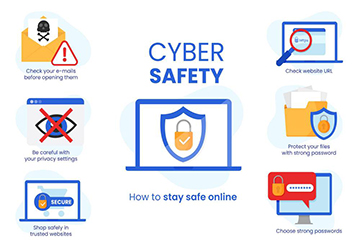Cybersecurity has become increasingly vital in today's interconnected world, with organizations and individuals facing escalating cyber threats. The rapid advancement of technology and the growing reliance on digital platforms have heightened the need for robust cybersecurity measures. Protecting sensitive data, mitigating risks, and ensuring the integrity of systems and networks have become top priorities for businesses and individuals alike.
This article will explore the top 10 best practices to enhance cybersecurity. These practices encompass a range of preventive, proactive, and responsive strategies that can bolster defenses, thwart attacks, and promote a secure digital environment.

10 Essential Powerful Practices to Safeguard Your Digital World
We will present the top 10 powerful practices for safeguarding your valuable assets and ensuring a secure online presence. Get ready to empower your digital defenses and confidently navigate the ever-evolving universe of cyber threats.
1.Use Strong Passwords and Multifactor Authentication
By implementing these security measures; you can effectively prevent hackers from guessing or cracking your passwords, reducing the risk of illegal access to your accounts and devices. Strong, unique, and regularly changed passwords make it harder for hackers to misuse your credentials. Additionally, incorporating multifactor authentication adds an extra layer of security by requiring additional verification steps, such as a code sent to your cell or a fingerprint tap.
2.Updating Your Software and Hardware
It lets you fix vulnerabilities and bugs that hackers may exploit to compromise your data, systems, networks, or devices. By keeping your software and hardware up to date, you stay aligned with the latest security standards and features that enhance your online privacy and security. It ensures you can use new encryption algorithms, antivirus definitions, firewall rules, and privacy settings, bolstering your defense against cyber threats. Moreover, avoiding outdated or unsupported software and hardware mitigates risks and ensures you receive the necessary security updates and technical support.
3.Using Encryption and VPN
Encryption protects your data from unauthorized access or disclosure, ensuring that sensitive information remains secure. You comply with data protection and privacy regulations by encrypting your data at rest and in transit. Additionally, a VPN creates a secure connection between your device and the internet, shielding your online activities from hackers, trackers, and snoopers. It enhances online privacy and security by encrypting your traffic and concealing your IP address.
4.Avoiding Phishing and Malware
Haphazard attempts can trick you into divulging personal information, giving hackers access to your accounts and leading to identity theft or financial loss. You can prevent hackers from obtaining your knowledge by being cautious, verifying sender identities, and refraining from sharing sensitive data. Similarly, malware can infect your device and compromise your privacy and security. By being vigilant, avoiding suspicious downloads, using antivirus software, and maintaining it up to date, you can protect your data and prevent harmful actions.
5.Backing Up Your Data
It ensures that you can recover your data in the event of data loss, corruption, deletion, or a ransomware attack. By creating copies of your essential files and storing them in a separate location, you can restore your data if your original device is damaged or compromised. Regularly backing up your data using reliable methods such as external hard drives or cloud services protects you against various risks. Additionally, testing your backups periodically ensures their integrity and helps you identify any issues in advance.

6.Securing Your Network
It prevents hackers from accessing or tampering with your online traffic and devices, protecting you from cyber threats. Using a strong password and changing default settings for your Wi-Fi router, you can fortify your wireless network against unauthorized access. Enabling encryption, such as WPA2, ensures that your online traffic remains encrypted and unreadable to unauthorized parties. Restricting unnecessary remote access and file-sharing features minimizes potential vulnerabilities. Lastly, a firewall blocks unauthorized traffic, enhancing your network's security.
7.Being Careful About What You Share Online
By exercising caution, you can prevent hackers from accessing your personal information and protect your online content. Limiting the amount of personal information you share on social media, blogs, or forums can make it harder for hackers to target or impersonate you. Adjusting your privacy settings lets you control who can see or access your online content, ensuring unauthorized individuals cannot exploit it.
8.Educating Yourself and Others
By increasing awareness and understanding of common cyber threats, you can reduce human errors and vulnerabilities that hackers exploit. Learning about creating strong passwords, recognizing phishing attempts, and protecting personal information strengthens your defenses. Staying informed about the latest cybersecurity trends, threats, and best practices ensures you adapt to the evolving landscape. Sharing your knowledge and experiences with others fosters a collective effort in cybersecurity, spreading awareness and building a supportive network.
9.Reporting And Responding to Incidents
It lets you minimize damage, recover data, restore systems, and prevent further attacks. By promptly reporting incidents, you can obtain necessary assistance and support from relevant authorities, such as IT departments, service providers, or law enforcement agencies. Following their instructions and advice helps you effectively address the incident and prevent worsening. Reporting incidents also ensures compliance with legal obligations and facilitates necessary actions, such as freezing accounts or canceling compromised cards.
10.Reviewing And Improving Your Cybersecurity
It ensures that your cybersecurity policies, procedures, and practices are practical and aligned with your goals. You can identify and address gaps or weaknesses by assessing their adequacy, relevance, and compliance. Additionally, staying updated with the latest cybersecurity trends and threats allows you to implement new measures to enhance your security. Seeking feedback and suggestions from others fosters collaboration and enables you to learn from their experiences and insights.
Wrap-Up!
Enhancing cybersecurity is of utmost importance in today's digital landscape. By combining the top 10 best practices, individuals and organizations can significantly improve their security posture and protect their digital assets.
These practices include using strong and unique passwords, enabling two-factor authentication, keeping software up to date, regular data backups, utilizing reliable antivirus software, promoting cybersecurity awareness among employees, securing Wi-Fi networks, deploying firewalls, limiting user privileges, and conducting regular security audits.


